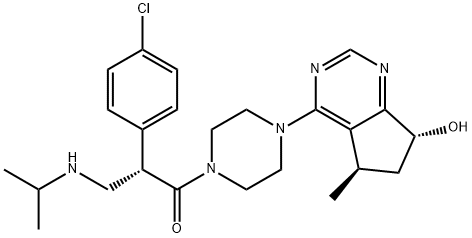PHT-427
Synonym(s):4-Dodecyl-N-(1,3,4-thiadiazol-2-yl)benzenesulfonamide, PDK1 Inhibitor III, PHT-427;Akt Inhibitor XIV - CAS 1191951-57-1 - Calbiochem
- CAS NO.:1191951-57-1
- Empirical Formula: C20H31N3O2S2
- Molecular Weight: 409.61
- MDL number: MFCD18384970
- SAFETY DATA SHEET (SDS)
- Update Date: 2025-12-26 16:58:18

What is PHT-427?
The Uses of PHT-427
PHT-427 is a dual Akt and PDPK1 inhibitor with Ki of 2.7 μM and 5.2 μM, respectively.
The Uses of PHT-427
PHT-427 is a pleckstrin homology domain inhibitor to Akt and PKB Kinase (PDPK1). It can also be used for therapeutic use and biological study of mathematical modeling and parametric analysis of nanoparticle encapsulation and controlled release of a hydrophobic kinase inhibitor PHT-427.
What are the applications of Application
PHT-427 is a pleckstrin homology domain inhibitor to Akt and PKB Kinase (PDPK1)
Biological Activity
pht-427 is an inhibitor of akt and pdpk1 (ki =2.7 μm and 5.2 μm, respectively).akt is a serine/threonine-specific protein kinase that plays a vital role in multiple cellular processes including glucose metabolism, apoptosis, cell proliferation, transcription and cell migration etc.in bxpc-3 cells, pht-427 showed inhibition upon akt function with ic50 value of 8.6±0.8 μm and for its downstream substrates. pht-427 reduced the akt phosphorylation on ser473 residue and did not decrease total akt protein level. pht-427 also inhibited p70s6k and gsk3β in a dose-dependent manner. [1][2]in scid (severe combined immunodeficiency) mice of bxpc-3 pancreatic cancer xenografts, administration of pht-427 exerted prominent antitumor activity that halted tumor growth. pht-427 in combination with erlotinib exhibited greater than additive antitumor activity in nsc lung cancer and with paclitaxel in breast cancer. [1][2]
Enzyme inhibitor
This orally bioavailable, dual Akt/PDPK1 inhibitor (F.Wt. = 409.61; CAS 1191951-57-1 and 1178893-77-0; Solubility (25°C): 80 mg/mL DMSO, <1 mg/mL Water), known systematically as 4-dodecyl-N-(1,3,4-thiadiazol-2- yl)benzenesulfonamide, targets Akt (also known as Protein Kinase B, or PKB) and 3-phosphoinositide-dependent protein kinase-1, with Ki of 2.7 μM and 5.2 μM, respectively. PHT-427 was designed to bind to the pleckstrin homology (PH) auto-inhibitory domains of the signal cascade protein kinase Akt.
Storage
-20°C
References
1. meuillet ej, zuohe s, lemos r et al. molecular pharmacology and antitumor activity of pht-427, a novel akt/phosphatidylinositide-dependent protein kinase 1 pleckstrin homology domain inhibitor. mol cancer ther. 2010 mar;9(3):706-17.2. moses sa, ali ma, zuohe s et al. in vitro and in vivo activity of novel small-molecule inhibitors targeting the pleckstrin homology domain of protein kinase b/akt. cancer res. 2009 jun 15;69(12):5073-81.
Properties of PHT-427
| Melting point: | 126-127 °C(Solv: hexane (110-54-3); ethyl acetate (141-78-6)) |
| Boiling point: | 535.0±43.0 °C(Predicted) |
| Density | 1.162 |
| storage temp. | +2C to +8C |
| solubility | Chloroform, Methanol (Slightly) |
| form | White solid |
| pka | 6.03±0.40(Predicted) |
| color | White to Off-White |
Safety information for PHT-427
| Signal word | Warning |
| Pictogram(s) |
 Exclamation Mark Irritant GHS07 |
| GHS Hazard Statements |
H302:Acute toxicity,oral H315:Skin corrosion/irritation H320:Serious eye damage/eye irritation H335:Specific target organ toxicity, single exposure;Respiratory tract irritation |
| Precautionary Statement Codes |
P261:Avoid breathing dust/fume/gas/mist/vapours/spray. P280:Wear protective gloves/protective clothing/eye protection/face protection. P301+P312:IF SWALLOWED: call a POISON CENTER or doctor/physician IF you feel unwell. P302+P352:IF ON SKIN: wash with plenty of soap and water. P305+P351+P338:IF IN EYES: Rinse cautiously with water for several minutes. Remove contact lenses, if present and easy to do. Continuerinsing. |
Computed Descriptors for PHT-427
New Products
4,4-Difluoropiperidine hydrochloride tert-butyl 9-methoxy-3-azaspiro[5.5]undecane-3-carboxylate Indole Methyl Resin N-Isopropylurea N,N-Dicyclohexylcarbodiimide(DCC) MELDRUMS ACID 5-METHYLISOXAZOLE-4-CARBOXYLIC ACID Magnessium Bis glycinate Zinc ascorbate 1-bromo-2-butyne 2-acetamidophenol 9(10H)-anthracenone Erythrosin B, 4-Piperidinopiperidine 2-((4-morpholinophenylamino) (methylthio) methylene) malononitrile 2,4-dihydroxybenzaldehyde 3-(4-morpholinophenylamino)-5-amino-1H-pyrazole-4-carbonitrile Methyl 2-methylquinoline-6-carboxylate 2,6-dichloro-4-nitropyridine 4-Bromo-2-chlorobenzonitrile 2-(benzylamino)acetic acid hydrochloride 4-(tert-Butoxycarbonylamino)but- 2-ynoic acid 3,4-dihydro-2H-benzo[b][1,4]dioxepine 1-Phenyl-1-cycloprppanecarboxylicacidRelated products of tetrahydrofuran
You may like
-
 3-(4-amino-1-oxoisoindolin-2-yl)-1-methylpiperidine-2,6-dione 98%View Details
3-(4-amino-1-oxoisoindolin-2-yl)-1-methylpiperidine-2,6-dione 98%View Details -
 1-methylindoline-2,3-dione 98%View Details
1-methylindoline-2,3-dione 98%View Details
2058-74-4 -
 614-19-7 98%View Details
614-19-7 98%View Details
614-19-7 -
 3112-85-4 Methyl phenyl sulfone 98%View Details
3112-85-4 Methyl phenyl sulfone 98%View Details
3112-85-4 -
 20677-73-0 (2,2-diethoxyethyl)methylamine 98%View Details
20677-73-0 (2,2-diethoxyethyl)methylamine 98%View Details
20677-73-0 -
 3-(4-(hydroxyamino)-1-oxoisoindolin-2-yl)piperidine-2,6-dione 98%View Details
3-(4-(hydroxyamino)-1-oxoisoindolin-2-yl)piperidine-2,6-dione 98%View Details -
 57381-49-4 2-bromo-4-chlorobenzonitrile 98%View Details
57381-49-4 2-bromo-4-chlorobenzonitrile 98%View Details
57381-49-4 -
 4,6-dichloropyrimidine-5-carbaldehyde 98%View Details
4,6-dichloropyrimidine-5-carbaldehyde 98%View Details
5305-40-8






